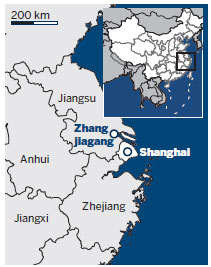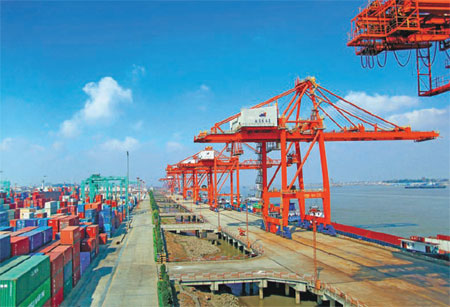Zhangjiagang Special:Thriving port sailing small city to success
( China Daily )
Updated: 2014-06-12
|
|||||||||
With 127 berths and 33 Fortune 500 companies Zhangjiagang port is becoming the growth engine of the local area.
The port, which lies in Zhangjiagang city, in Jiangsu province, is built on the lower reaches of the Yangtze River.
It handled 260 million tons of cargo in 2013 and has an import and export volume of 50.9 million tons.
The port has expanded enormously over the past 30 years and played an important role in boosting the city's economy.
Today the port accounts for more than 60 percent of Zhangjiagang's total revenue.
Zhangjiagang used to be one of the poorest counties in Suzhou city in Jiangsu province.
It turned into a city in 1986 and since then the local government found a new development path, which was to position itself as the main port city in the area.
"With the port, the only free trade zone of Jiangsu province and a number of large local enterprise groups, Zhangjiagang has a solid economic foundation and comparative advantage in developing a port-based scale economy and private economy," an official said.

According to the local government, Zhangjiagang's GDP reached 214.5 billion yuan ($35.75 billion) and the revenue of local government was 15.42 billion yuan in 2013.
The annual income of the local urban and rural residents last year were 43,400 yuan and 21,700 yuan respectively.
Eight of Zhangjiagang's 19 companies are now ranked among China's top 500 private enterprises.
One of the local businesses, the Shagang Group, is listed as a world Fortune 500 enterprise.
Although Zhangjiagang is a relatively small city in China, with a population of 1.54 million, its achievements are pretty impressive.
Zhangjiagang has the only port for importing finished automobiles in Jiangsu province.
It was also one of the first national demonstration bases for remanufacturing, which has positively impacted development.
The 63.57-kilometer-long port has prestigious international companies like Dow Chemical docking along its shore.
In 2013, the total import and export of automobiles in Zhangjiagang port was 20,000 units.
In addition to automobiles, the port also stores and transports steels, grain, oil, coal and chemical products.
According to the government, the port was ranked third for importing and exporting wood around the nation.
As the port developed trade zones and industrial parks were built in the city.
These included the Zhangjiagang Free Trade Zone, the Yangtze River International Chemical Industrial Park, the Yangtze River International Metallurgy Industrial Park and the Zhangjiagang Logistic Park.
Several logistics and container companies were set up in the port area to meet growth demand.
Many of them quickly developed systems and affiliated facilities to provide customers professional services.
The Zhangjiagang Win Hanverky Container Terminal Co was set up in the port in 1992 and has a modern container terminal with advanced facilities, a company executive said.
The company occupies a land area of 400,000 square meters and has a cargo port, disassembly warehouses, repair workshops and many other facilities.
It uses a computer information management system, which covers both the field and back office including the dangerous goods warehouse, to ensure the safety and efficiency.
According to the company, it has three 10,000-ton berths and provides services including container loading and unloading, storage, cargo disassembly, dangerous goods management, container repair and shipping.
The company runs both domestic and international routes to destinations including Japan and South Korea.
Organizations and government offices such as Customhouse, the Administration of Quality Supervision, Inspection and Quarantine, and the Marine Safety Administration surround the berths to provide convenience for international traders.
Zhangjiagang port's fast development relied on excellent regional advantages and policy advantages.
In recent years the port won several awards in China, including the National Civilized port and National Model Port of Operation and Management.
Today the port has 52 container routes and maintains trading relationships with 473 port cities from 71 countries and regions.
The Zhangjiagang government plans to optimize its coastal areas and upgrade their industrial structure in the future.
huangliying@chinadaily.com.cn
|
Zhangjiagang port accounts for more than 60 percent of Zhangjiagang city's total revenue. Provided to China Daily |
|
Zhangjiagang port attracted a number of leading photographers from Asian media sources during a recent tour to China. Wang Jing / China Daily |
(China Daily 06/12/2014 page15)









